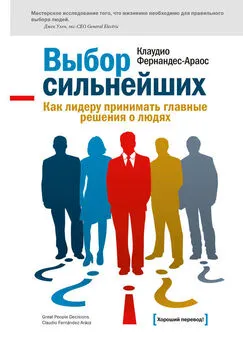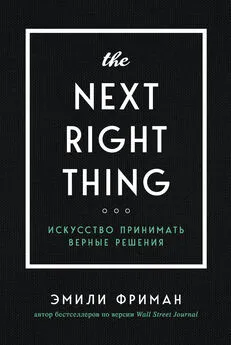Клаудио Фернандес-Араос - Выбор сильнейших. Как лидеру принимать главные решения о людях
- Название:Выбор сильнейших. Как лидеру принимать главные решения о людях
- Автор:
- Жанр:
- Издательство:Литагент МИФ без БК
- Год:2016
- Город:Москва
- ISBN:978-5-91657-438-8
- Рейтинг:
- Избранное:Добавить в избранное
-
Отзывы:
-
Ваша оценка:
Клаудио Фернандес-Араос - Выбор сильнейших. Как лидеру принимать главные решения о людях краткое содержание
Выбор сильнейших. Как лидеру принимать главные решения о людях - читать онлайн бесплатно ознакомительный отрывок
Интервал:
Закладка:
68
William Poundstone, How Would You Move Mount Fuji? (Boston: Little, Brown, 2003).
69
Nathan Bennett and Stephen A. Miles, “Second in Command: The Misunderstood Role of the Chief Operating Officer,” Harvard Business Review, May 2006: 70–78.
70
David Dunning, Chip Heath, and Jerry M. Suls, “Flawed Self-Assessment: Implications for Health, Education, and the Workplace,” American Psychological Society 5(3), 2004.
71
Nigel Nicholson, Managing the Human Animal (Texere Publishing, 2000).
72
Peter L. Bernstein, Against the Gods (New York: John Wiley & Sons, 1996); and Hersh Shefrin, Beyond Greed and Fear (Harvard Business School Press, 1996).
73
Timothy D. Wilson, Strangers to Ourselves (Belknap Press of Harvard University Press, 2002), p. 17.
74
Chuck Lucier, Rob Schuyt, and Eric Spiegel, “CEO Succession 2002: Deliver or Depart,” Strategy + Business 31, 2003.
75
Claudio Fernández-Aráoz, “Managing CEO Succession,” Global Agenda 2005, pp. 182–184.
76
David Dunning, Chip Heath, and Jerry M. Suls, “Flawed Self-Assessment: Implications for Health, Education, and the Workplace,” American Psychological Society 5(3), 2004.
77
Private conversation with Jack Welch, Boston, February 2006.
78
Boris Groysberg, Andrew N. McLean, and Nitin Nohria, “Are Leaders Portable?” Harvard Business Review, May 2006: 92–100.
79
Max H. Bazerman, Judgment in Managerial Decision Making (Hoboken, NJ: John Wiley & Sons, 2002).
80
Chris Argyris, Teaching Smart People How to Learn (Harvard Business School Press, 2004).
81
Paul Ekman, Telling Lies (W.W. Norton, 2001, 1992, 1985), pp. 329–330.
82
David Callahan, The Cheating Culture (Harcourt Books, A Harvest Book, 2004), p. 220.
83
Malcolm Gladwell, The Tipping Point (Little, Brown, 2002, 2000), p. 155.
84
Timothy D. Wilson, Strangers to Ourselves (Harvard University Press/Belknap Press, 2002), p. 137.
85
Jack Welch, “How to Win: An Exclusive Excerpt from the New Book by the Legendary CEO,” Newsweek, April 4, 2005: 41.
86
THE FOCUS online ( http://www.ezifocus.com/content/thefocus/issue/article.php/article/54300471), vol. X/l, 2006. Заглавная тема выпуска Jim Collins: “Filling the Seats: How People Decisions Help Build a Great Company.”
87
Valerie I. Sessa and Jodi J. Taylor, Executive Selection: Strategies for Success (Jossey-Bass: Center for Creative Leadership, 2000), p. 47.
88
Сумма превышает сто процентов, поскольку в большинстве случаев в принятии решений задействовано множество человек.
89
Valerie I. Sessa, Robert Kaiser, Jodi J. Taylor, and Richard J. Campbell, “Executive Selection: A Research Report on What Works and What Doesn’t” (Center for Creative Leadership, 1998), p. 42. Вновь сумма превышает сто процентов, поскольку в большинстве случаев в принятие каждого из решений были вовлечены многие участники.
90
Annita Florou and Martin J. Conyon, Top Executive Dismissal, Ownership and Corporate Performance (The Wharton School, University of Pennsylvania, and London Business School, February 2002), revised.
91
Rachel M. Hayes, Paul Oyer, and Scott Schaefer, “Co-Worker Complementarity and the Stability of Top Management Teams,” research paper no. 1846 (R) (Stanford Graduate School of Business, January 2005).
92
McKinsey & Co., Egon Zehnder International Talent Management Survey, 2004.
93
Jack Welch with Suzy Welch, Winning (HarperCollins, 2005), p. 65.
94
Jeffrey Pfeffer and Robert I. Sutton, Hard Facts, Dangerous Half-Truths and Total Nonsense (Harvard Business School Press, 2006), p. 191.
95
Michael Y. Yoshino and Karin-Isabel Knoop, “Argentina’s YPF Sociedad Anónima,” Cases A to E (Harvard Business School Publishing, 1995, 1998, 1999).
96
“The Toughest Jobs in Business,” Fortune, February 20, 2006: 54.
97
Noam Wasserman, Bharat Anand, and Nitin Nohria, “When Does Leadership Matter? The Contingent Opportunities View of CEO Leadership,” working paper no. 01–063 (Harvard Business School, 2001).
98
Private conversation with Jack Welch, Boston, February 2006.
99
Boris Groysberg, Andrew N. McLean, and Nitin Nohria, “Are Leaders Portable?” Harvard Business Review, May 2006: 92.
100
David A. Light, “Who Goes, Who Stays?” Harvard Business Review, January 2001: 35–44.
101
Michael Beer and Nitin Nohria, Breaking the Code of Change (Harvard Business School Press, 2000).
102
Marc Gerstein and Heather Reisman, “Strategic Selection: Matching Executives to Business Conditions,” from The Art of Managing Human Resources, edited by Edgar H. Schein, Sloan Management Review 24(2), winter 1983.
103
Charles O’Reilly, David F. Caldwell, and Jennifer A. Chatman, How Leadership Matters: The Effects of Leadership Alignment on Strategic Execution (Stanford University, Santa Clara University, and the University of California, June 2005).
104
Neal Schmitt and Walter C. Borman and Associates, Personnel Selection in Organizations (Jossey-Bass, 1993), Chapter 14.
105
Jim Collins, Good to Great (HarperCollins, 2001), p. 41.
106
Kathleen A. Farrell (University of Nebraska) and David A. Whidbee (Washington State University), “The Impact of Firm Performance Expectations on CEO Turnover and Replacement Decisions” (May 2003). JAE Boston Conference, October 2002. Available at SSRN: http://ssrn.com/abstract=318968.
107
Rakesh Khurana and Nitin Nohria, “The Performance Consequences of CEO Turnover” (March 15, 2000). Available at SSRN ( http://ssrn.com/abstract=219129) or DOI (10.2139/ssrn. 219129).
108
Noam Wasserman, “Founder-CEO Succession and the Paradox of Entrepreneurial Success,” Organization Science 14(2), March – April 2003: 149–172 (лауреат Мемориальной премии имени Аага Соренсена 2003 г. за исследования в области социологии)
109
George S. Day and Paul J.H. Schoemaker, Peripheral Vision: Detecting the Weak Signals That Will Make or Break Our Company (Harvard Business School Press, 2006), pp. 22–23.
110
David Maister, “Strategy and the Fat Smoker” (this article can be accessed at David Maister’s web site: http://davidmaister.com).
111
Keith Epstein, “Crisis Mentality,” Stanford Social Innovation Review 4(1), spring 2006.
112
Jack Welch and Suzy Welch, Winning (HarperCollins, 2005), pp. 72–73.
113
Jack Welch and Suzy Welch, Winning (HarperCollins, 2005), p. 35.
114
Frederick F. Reichheld, Loyalty Rules: How Today’s Leaders Build Lasting Relationships (Bain & Company, 2001), p. 7.
115
Frederick F. Reichheld, ed. The Quest for Loyalty: Creating Value through Partnership (Boston: Harvard Business School Press, 1990), Part II, Chapter 3, pp. 67–72.
116
James M. Kouzes and Barry Z. Posner, The Leadership Challenge, 3rd ed. (Jossey-Bass, 2002), p. 25.
117
John T. Horn, Dan P. Lovallo, and S. Patrick Viguerie, “Learning to Let Go: Making Better Exit Decisions,” The McKinsey Quarterly 2, 2006: 64–75.
118
THE FOCUS online ( http://www.ezifocus.com/content/thefocus/issue/article.php/article/54300471), vol. X/l, 2006. Keynote topic by Jim Collins: “Filling the Seats: How People Decisions Help Build a Great Company.”
119
Frank L. Schmidt and John E. Hunter, “The Validity and Utility of Selection Methods in Personnel Psychology: Practical and Theoretical Implications of 85 Years of Research Findings,” Psychological Bulletin 124(2), 1998: 262–274.
120
Boris Groysberg, Andrew N. McLean, and Nitin Nohria, “Are Leaders Portable?” Harvard Business Review, May 2006: 92–100.
121
Neil Anderson and Vivian Shackleton, Successful Selection Interviewing (Blackwell Publishers, 1993), p. 30.
122
Критерий совестливость обладает крайне низким коэффициентом валидности (около 0,20). Чтобы разобраться с последствиями подобного низкого уровня, следует возвести уровень коэффициента в квадрат, чтобы определить процент отклонения результативности, который объясняется этим критерием. Возводя в квадрат 0,20, мы получаем 0,04, что означает, что лишь около 4 % разницы результативности работы может быть объяснено этим критерием. Иными словами, он обладает крайне ограниченной полезностью.
123
Этот пример детально обсуждается автором Annie Murphy Paul в The Cult of Personality (Free Press/Simon & Schuster, 2004).
124
Daniel Goleman, Emotional Intelligence: Why It Can Matter More Than IQ (Bantam Books, October 1995).
125
David C. McClelland, “Testing for Competence Rather Than for ‘Intelligence’,” American Psychologist, January 1973.
126
Richard E. Boyatzis, The Competent Manager: A Model for Effective Performance (New York: John Wiley & Sons, 1982).
127
Lyle M. Spencer, Jr. and Signe M. Spencer, Competence at Work (New York: John Wiley & Sons, 1993).
Читать дальшеИнтервал:
Закладка:










